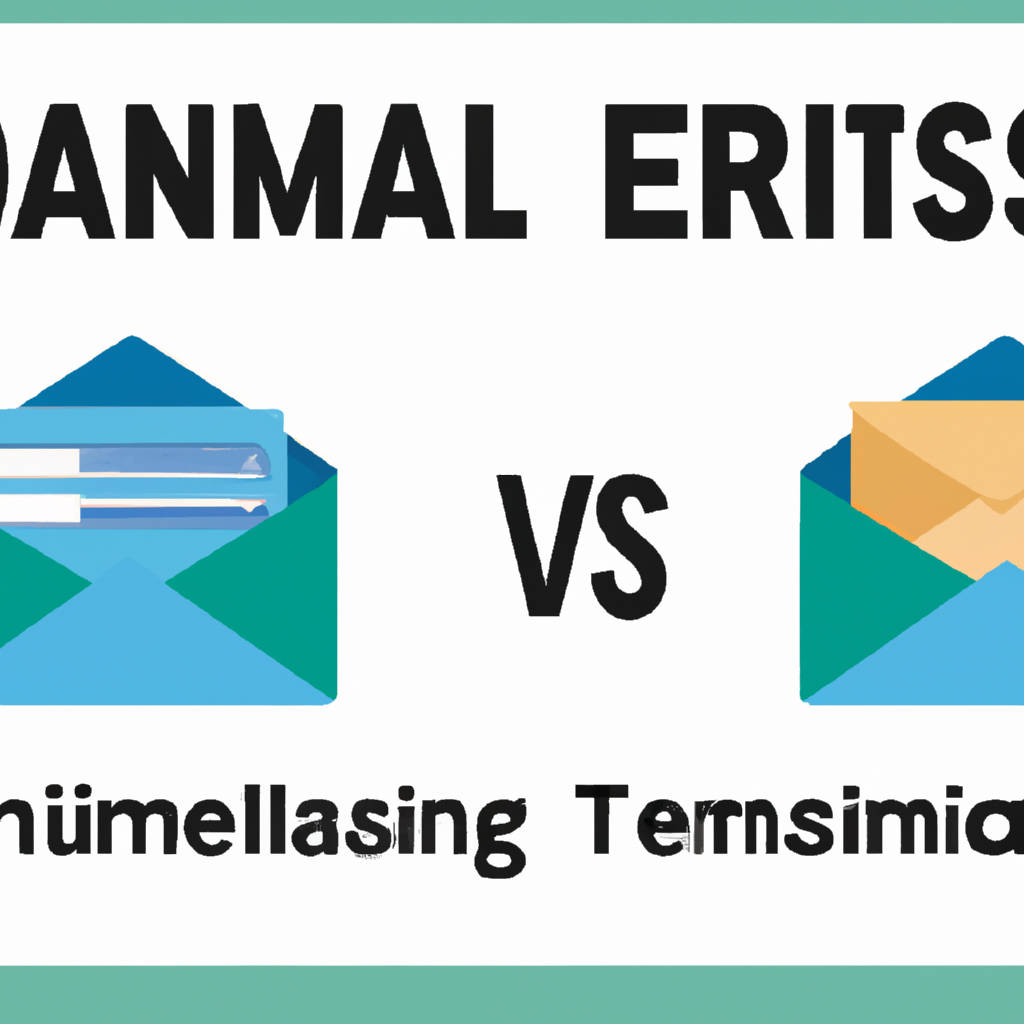A transactional email is a type of email that is sent to an individual based on a specific action or transaction that they have taken. These emails are typically automated and are triggered by events such as a purchase confirmation, account registration, or password reset. The purpose of a transactional email is to provide the recipient with important information related to their transaction, such as order details, account updates, or password reset instructions.
These emails are different from promotional emails in that they are not used for marketing purposes, but rather to provide necessary and timely information to the recipient. Transactional emails are an essential part of any online business’s communication strategy, as they help to build trust and provide a seamless experience for customers.

Defining Transactional Email
Transactional email is a type of communication that is sent to an individual based on a specific action or transaction that they have taken. This type of email is typically automated and is used to provide information or updates related to the transaction that was completed. Examples of transactional emails include order confirmations, shipping notifications, password resets, and account updates. These emails are intended to provide the recipient with important information that they need to know in order to complete a transaction or stay informed about their account. Transactional emails are often sent in response to a customer’s action, such as making a purchase, requesting information, or updating their account details. They are not typically used for promotional purposes, but rather to provide necessary information to the recipient. Transactional emails are an important part of the overall customer experience, as they help to keep customers informed and engaged with a company’s products or services. By providing timely and relevant information to recipients, transactional emails can help to build trust and loyalty with customers, leading to increased satisfaction and retention. Overall, transactional emails play a crucial role in keeping customers informed and engaged throughout their interactions with a company.
Transactional Email vs. Marketing Email
Transactional emails and marketing emails serve different purposes in the realm of email communication. Transactional emails are typically triggered by a specific action taken by a user, such as making a purchase, signing up for a service, or resetting a password. These emails are essential for providing users with important information related to their transaction, such as order confirmations, shipping updates, or account notifications.
On the other hand, marketing emails are designed to promote products, services, or events to a larger audience. These emails aim to drive engagement, build brand awareness, and ultimately generate sales. While both types of emails are valuable tools for businesses, it is important to understand the differences between them and use them appropriately.
Transactional emails should focus on delivering relevant and timely information to users, while marketing emails should be crafted to capture the attention of recipients and encourage them to take action. By utilizing both types of emails effectively, businesses can create a well-rounded email marketing strategy that connects with users on multiple levels and drives results.

Benefits of Sending Transactional Emails
Transactional emails are an essential tool for businesses looking to communicate with their customers in a timely and efficient manner. By sending transactional emails, companies can provide important information such as order confirmations, shipping notifications, and account updates to their customers. These emails help to streamline the customer experience and ensure that important information is delivered promptly.
Additionally, transactional emails can be personalized to each individual customer, creating a more meaningful and engaging interaction. This personalization can help to build trust and loyalty with customers, ultimately leading to increased sales and customer satisfaction. Furthermore, transactional emails can also serve as a valuable marketing tool, as they provide an opportunity to promote related products or services to customers who have already shown an interest in a particular product or service.
By leveraging transactional emails in this way, businesses can drive additional revenue and maximize the value of each customer interaction. Overall, sending transactional emails can have a range of benefits for businesses, including improved customer communication, increased sales, and enhanced marketing opportunities.
How Transactional Email Works
Transactional emails are automated messages that are sent to customers based on specific actions they have taken, such as making a purchase, signing up for a newsletter, or creating an account. These emails are an essential part of any business’s communication strategy as they provide customers with important information about their transactions and help to build a relationship with them.
The way transactional emails work is relatively simple. When a customer completes an action that triggers a transactional email, such as making a purchase, the system automatically generates and sends out an email with the relevant information. This information typically includes details about the transaction, such as the items purchased, the total cost, and the shipping information.
One of the key benefits of transactional emails is that they are highly personalized and relevant to the recipient. This helps to build trust and credibility with customers, as they know that the information they are receiving is directly related to their interactions with the business. Additionally, transactional emails can help to drive engagement and encourage repeat purchases, as they provide customers with valuable information and updates about their transactions.
Overall, transactional emails are an important tool for businesses to communicate with their customers in a timely and relevant manner. By providing customers with important information about their transactions and building a relationship with them through personalized communication, businesses can help to increase customer satisfaction and loyalty.

Types of Transactional Emails for Ecommerce
Transactional emails are an essential component of any ecommerce business, providing important information to customers about their purchases or interactions with the company. There are several types of transactional emails that are commonly used in the ecommerce industry. One type is the order confirmation email, which is sent to customers immediately after they make a purchase.
This email typically includes details about the order, such as the items purchased, the total cost, and the shipping information. Another type of transactional email is the shipping confirmation email, which is sent to customers once their order has been shipped. This email usually includes a tracking number so that customers can monitor the progress of their delivery. Additionally, there are emails for order updates, such as notifications about backorders or delays in shipping.
These emails help keep customers informed about the status of their orders and manage their expectations. Finally, there are transactional emails for customer feedback, such as review requests or satisfaction surveys. These emails provide valuable insights for the company and help improve the overall customer experience. Overall, transactional emails play a crucial role in ecommerce by providing customers with important information and enhancing their shopping experience.
Best Practices for Transactional Emails
Transactional emails are an essential component of any successful email marketing strategy. These types of emails are sent in response to a specific action taken by a customer, such as a purchase or a subscription. To ensure that your transactional emails are effective and engaging, it is important to follow best practices. One key best practice is to ensure that the email is personalized and relevant to the recipient.
This can be achieved by including the recipient’s name, order details, and other relevant information in the email. Additionally, it is important to keep the email concise and to the point, as recipients are more likely to engage with emails that are easy to read and understand. Another best practice is to include a clear call to action in the email, such as a link to track an order or to provide feedback. This can help to drive engagement and encourage recipients to take the desired action.
Finally, it is important to test and optimize your transactional emails to ensure that they are achieving the desired results. This can involve A/B testing different subject lines, designs, and calls to action to see what resonates best with your audience. By following these best practices, you can ensure that your transactional emails are effective and help to build strong relationships with your customers.

Using Transactional Email in Constant Contact
Transactional emails are an important aspect of email marketing, as they provide customers with important information about their interactions with a business. Constant Contact offers a platform that allows businesses to easily create and send transactional emails to their customers. These emails can include order confirmations, shipping notifications, password reset requests, and more.
By utilizing transactional emails in Constant Contact, businesses can effectively communicate with their customers in a timely and personalized manner. This can help to improve customer satisfaction and build trust with the brand. Additionally, transactional emails can also help businesses to drive sales by including relevant product recommendations or promotions in the email content. Constant Contact provides businesses with the tools they need to track the performance of their transactional emails, allowing them to analyze open rates, click-through rates, and other important metrics.
By monitoring the performance of their transactional emails, businesses can make data-driven decisions to optimize their email marketing strategy and improve overall customer engagement. Overall, using transactional email in Constant Contact can be a valuable tool for businesses looking to enhance their communication with customers and drive sales.
Enhancing Customer Relations with Transactional Emails
Transactional emails are a key component in enhancing customer relations and building trust with your audience. These emails provide customers with important information regarding their transactions, such as order confirmations, shipping updates, and receipts. By utilizing these emails effectively, businesses can create a seamless and personalized experience for their customers, ultimately increasing customer satisfaction and loyalty.
Additionally, transactional emails provide an opportunity for businesses to engage with their customers in a meaningful way, offering personalized recommendations or promotions based on their previous purchases. By tailoring these emails to the individual customer’s preferences and behaviors, businesses can create a more personalized and engaging experience that fosters a strong connection with their audience. In today’s digital age, where customers expect instant communication and personalized experiences, transactional emails are a powerful tool for businesses to strengthen their customer relationships and drive repeat business.
By leveraging these emails effectively, businesses can not only provide customers with important information in a timely manner but also create a more personalized and engaging experience that fosters loyalty and trust. Ultimately, transactional emails are an essential component of any successful customer relations strategy and can have a significant impact on the overall success of a business.
